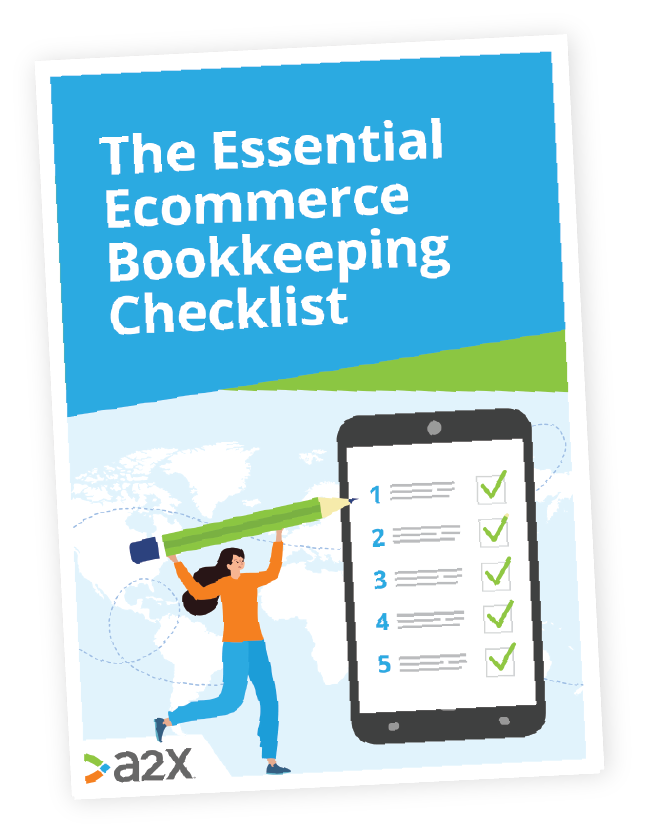
Are These Top 3 Accounting Mistakes Costing Your Ecommerce Business?

In a recent webinar, one of our A2X experts, Amy Crooymans, discussed three of the most common accounting mistakes made by ecommerce sellers.
These challenges can end up costing your business a lot of money and create further problems for you down the line.
We’ve summarized the key points made by Amy in the webinar, along with what you can do to avoid the mistakes mentioned.
*All quotes below are from Amy. *
In this blog about common ecommerce accounting mistakes:
Table of Contents
Want to feel completely confident in your ecommerce bookkeeping?
Businesses that document their processes grow faster and make more profit. Download our free checklist to get all of the essential ecommerce bookkeeping processes you need every week, month, quarter, and year.
Download it here
First, let’s review the two different accounting methods.
Cash accounting vs. accrual accounting
Before we get started, let’s make sure you’re up to speed on the difference between cash-based accounting and accrual-based accounting.
Why?
Because they’re critical when it comes to optimal ecommerce accounting.
The most crucial difference between the two methods comes down to timing:
Cash accounting records transactions when money changes hands.
Accrual accounting records transactions as they occur.
“Cash and accrual accounting are not just ways that you do business. They’re methodologies accounting for how you’ve done business.”
In ecommerce, accrual accounting comes out on top.
It provides a greater level of detail, allows for easier and more accurate forecasting, and is required by the GAAP for larger businesses.
Unfortunately, not all ecommerce sellers are familiar with this method.
Learn more: Cash accounting vs accrual accounting for ecommerce.
Why the difference matters for ecommerce accounting
Special considerations must be made for ecommerce accounting.
Your ecommerce transactions are occurring via your sales channel rather than directly in your bank. And they need to be tracked consistently month-to-month.
Since that’s not always how they’re reported, this can present a challenge.
Let’s take Amazon, for example.
Amazon pays sellers in batch deposits every two weeks.
The net deposit you receive in your bank account from Amazon is not just sales. It’s your sales minus any extra costs and fees.
Sales tax could be included in the settlements, which you must account for correctly to avoid compliance issues. You don’t get to keep it!
Finally, some sellers account for their COGS (Cost of Goods Sold) as they purchase products, rather than at the time of sale. This can result in skewed profit margins that directly affect all areas of your business.
To avoid these common mistakes, you need to use the correct accounting method. And that method is accrual-based accounting.
Mistake 1: Recording net deposits as income
This is the most common mistake we see as ecommerce accounting experts.
Net deposits could include any number of different transactions, not just your sales. Getting this wrong can result in unnecessary costs for your business.
“There are over 400 different transaction types that flow through a merchant account.”
How this mistake can cost your business
When you record net deposits as income, it directly and negatively affects your financial picture.
Here are some of the main problems this mistake can create:
Overstating or understating income numbers
You could be pushing up your margins by 50% or more, resulting in serious tax implications and inaccurate bookkeeping.
Not accounting for fees
It’ll be hard to know if your sales are increasing and decreasing or whether your total fee value is simply changing.
Timing issues surrounding deposits that span months
If you get paid across two periods (January and February, for example), you’ll find it challenging to accurately divide the net deposit into its respective pay periods.
Redoing your books when it’s time to sell your business
Incorrectly accounting for your income early on will result in headaches when you eventually try to sell your business. Accurate books are crucial for prospective buyers who need to know your company’s worth.
Mistake 2: Recording sales tax as income
“Sales tax doesn’t belong in a profit and loss sheet. It needs to be in a liability account in a balance sheet.”
Sales tax is something that governments take very seriously.
Getting your sales tax wrong can have significant implications for your business.
Often the problem comes when sales tax has been added to the profit and loss sheet, not the balance sheet.
This is an easy, but potentially costly mistake to make when using the cash accounting method.
Sales tax is often mistaken for income when net deposits are recorded as sales revenue.
How this mistake can cost your business
Recording sales tax as income can result in trouble both inside and outside your books.
Here are some of the main problems this mistake can create:
You spend money that isn’t yours
Once sales tax is collected, it’s recorded as a liability and submitted to the state. If you incorrectly categorize sales tax, you’ll need to pay the debt out of your own pocket.
Issues with compliance
States will backdate your sales tax balance. And they’re only getting more strict. So if you’ve been non-compliant for years, prepare to get a nasty bill.
You skew your profit margins
If you don’t know how much sales tax you’re supposed to pay, you won’t know your income and profit margins. Skewed profit margins create a negative snowball effect on your bookkeeping.
Mistake 3: Incorrect handling of COGS
For ecommerce sellers, it’s likely that your COGS is one of your biggest expenses.
**Accounting for COGS correctly is critical to calculate margins accurately. **
“[Accrual accounting] gives you a far better picture of how your business is doing month-to-month.”
Using the cash accounting method makes it easy to record the cost of your products incorrectly.
Inventory purchased should be recorded as an asset (rather than an expense).
This is the correct approach, as it accurately reflects the total value of your business and your current profit margins.
When you use cash accounting, inventory purchases are treated as COGS when you pay for them.
In accrual accounting, inventory is listed as an asset and only becomes COGS when you sell it, which is more true to what’s going on.
How this mistake can cost your business
When your COGS is handled incorrectly, you can’t calculate your profit margins accurately.
And inaccurate profit margins impact other areas of your business too.
Here are some of the main problems this mistake can create:
It’s hard to know which SKUs are performing well
If you can’t see how well your SKUs are performing, you’ll be blind to how well your business is doing across the board. It will also be difficult to know which you should invest more time and money in, and which aren’t getting you a return.
You set the wrong pricing for your products
If you don’t know your margins, your pricing judgments become guesses. You could miss out on increasing those margins in the long term.
You order the wrong quantity of stock
Over- or under-ordering of stock can cause multiple problems, such as unsatisfied customers, high storage fees, and wasted space.
Avoid these common mistakes with A2X
“If you ever want to sell your business, you need accrual accounting.”
Are you experiencing any of the challenges mentioned in this blog?
If you are, then it’s time to get a grip on your accounting with A2X.
A2X is an ecommerce accounting automation app. We make sure you have the right data in your accounting system, broken down in a way that prevents inaccuracy.
Start your free trial of A2X today.
Common questions about A2X
Get quick-fire answers to all your A2X questions below.
Where can I learn about A2X’s pricing?
Our pricing is divided into two options: Single-channel plans and multi-channel plans. The number of connections you need and the number of monthly orders you do determine the price of your plan.
See the links below for more specific pricing information:
- Shopify plans and pricing.
- Amazon plans and pricing.
- Walmart plans and pricing.
- eBay plans and pricing.
- Etsy plans and pricing.
- Multi-channel plans and pricing.
How do I add my accountant or bookkeeper to my A2X account? Is that possible?
There’s really no limit on the number of users you can have on an A2X account. Within the settings of A2X, you can add as many people as you like, and they’ll receive an invitation to join the account. If desired, you can even switch admin rights over to your accountant or bookkeeper.
Are there any development plans to build connections for additional sales channels?
A2X was originally built to support only Amazon sellers. We’ve since added Shopify, Walmart, eBay, and Etsy connections to our services. So, while we can’t confirm plans for further connections, it’s likely to happen given the continued growth of the A2X platform.
How do multi-channel sellers connect to the same accounting file? How does that setup look?
It’s very simple. In the upper-right corner of your A2X dashboard, you can click on an arrow that allows you to add as many other accounts as you want. You’ll then have access to all your accounts in a single space.
I’m looking for an accountant or bookkeeper. Where do you suggest I find one?
Our Ecommerce Accountant Directory is loaded with friendly and reliable experts. You can even filter between different services, regions, software, and sales channels to find the best fit for your business.
Are you ready to get automated, accurate bookkeeping?
Want to feel completely confident in your ecommerce bookkeeping?
Businesses that document their processes grow faster and make more profit. Download our free checklist to get all of the essential ecommerce bookkeeping processes you need every week, month, quarter, and year.
Download it here

